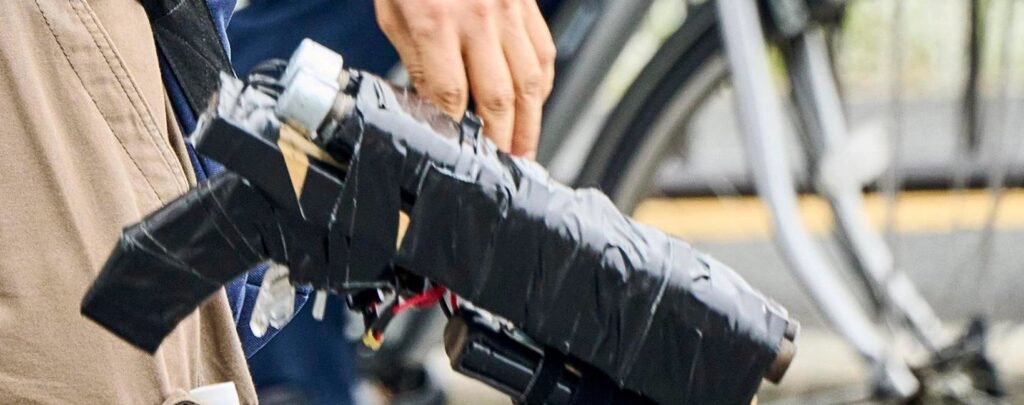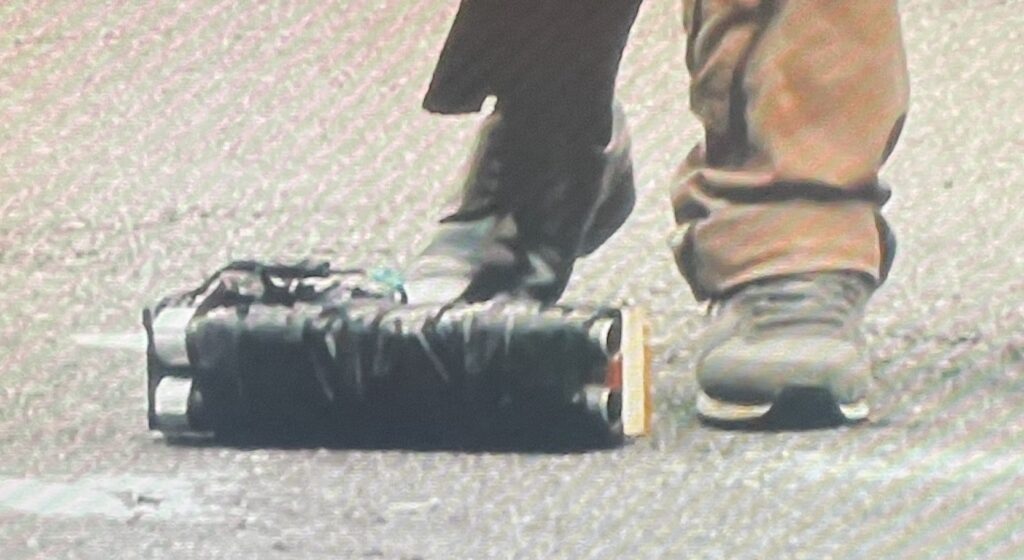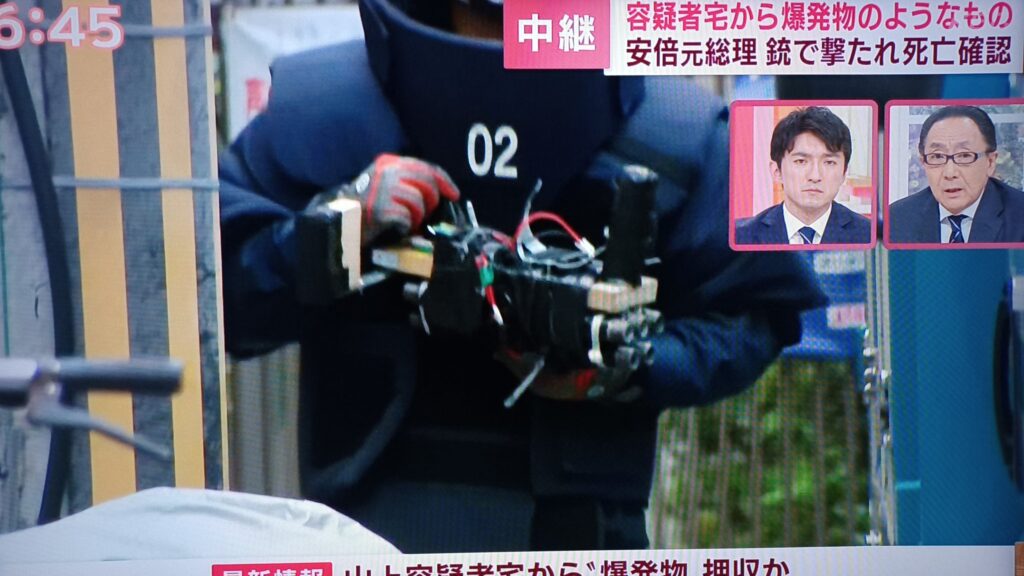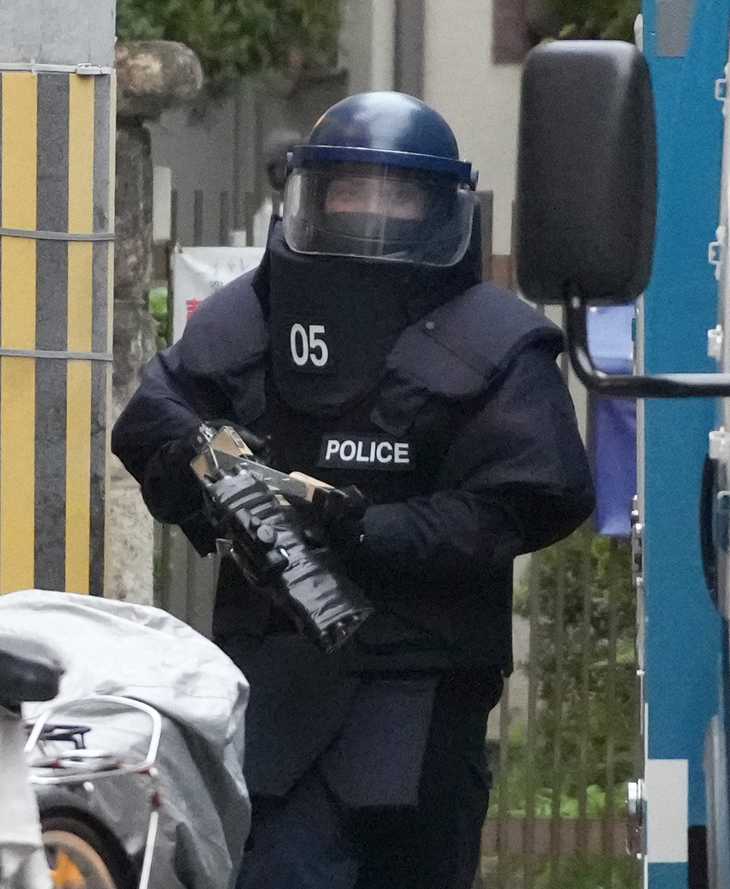N.R Jenzen-Jones & Patrick Senft
Around 1130 hrs local time on 8 July 2022, former Prime Minister of Japan, Shinzo Abe (Abe Shinzō; 安倍 晋三), was shot in Nara, Japan, with a craft-produced (‘privately made’) firearm. Videos of the shooting suggest that the assailant was within a few metres of the former Prime Minister when he discharged the weapon. The attacker fired twice, with the first shot apparently missing its target. The second shot struck Mr. Abe, with initial reports suggesting that he was hit in the chest and the neck. It is not clear at this stage whether multiple projectiles were loaded into each barrel, or how many projectiles struck the former Prime Minister. The statesman later succumbed to his injuries.

At the time of writing, little is definitively known about the firearm (see Figure 2) used in the attack. Only a relatively small number of pictures and video recordings of the incident have thus far surfaced. Nonetheless, it is possible to make some preliminary assessments about the design and capabilities of the weapon used in the attack. Additionally, the home of the assailant was raided by Japanese police following the attack, and photographs of two similar firearms have since emerged. Based on the available material, it appears that the assailant likely employed a craft-produced, muzzle-loading, double-barrel smoothbore weapon, using separate-loading ammunition which was initiated by an electric firing mechanism.

The barrels of the firearm appear to be constructed from two metal tubes (most likely commercially available pipe) that were sealed at the rear using screw-on endcaps. The barrels are attached to a piece of wood using black adhesive tape (probably electrical tape). A pistol grip is attached to the wooden body of the weapon. There may also be other fasteners which are not visible underneath the tape. Based on the general arrangement of the firearm, its design, and its apparent build quality, it is likely that the weapon was a smoothbore design—that is, the barrels were not rifled—and the ammunition was fired under relatively low pressures. The significant plumes of smoke generated when the weapon was fired indicate that it does not make use of commercial small arms ammunition propellant (‘smokeless powder’), and may instead use blackpowder or an alternative propellant. This makes the use of ‘separate-loading’ ammunition (i.e., propellant and projectile loaded separately into the weapon) more likely, as well as increasing the likelihood that the weapon was a muzzle-loading design—that is, loaded from the bore (‘front’ of the barrel), rather than the breech (‘rear’ of the barrel) of the firearm.

A popular design for simple craft-produced shotguns is the so-called ‘slam-fire shotgun’. Several observers have suggested this is the type of weapon used in the attack against Abe. However, these designs rely on conventional, impact-sensitive primers as found in modern small arms ammunition. The firing signature of the weapon suggests the use of an alternative propellant composition, as noted, and thus a slam-fire design is unlikely. The assailant likely used similar iron plumbing pipes and endcaps similar to those used on craft-produced firearms chambering conventional shotgun ammunition. However, the weapon appears to use an electric firing mechanism. Images of the firearm show that an electrical wire passes through each endcap. The trigger mechanism seems to connect these wires to two battery packs. There are several different designs of electrical firing mechanism. There have been, for example, significant developments focused on electric primers within the community of 3D-printed firearms designers. Probably the most prominent electric firing mechanism for 3D-printed firearms has been developed by the user ‘@SuckBoyTony1’. This mechanism uses an 80 kV High Voltage Pulse Generator that converts 6–12 V (the electric potential typically provided by battery packs such as that seen with the assailant’s weapon) into 80 kV. This high voltage creates a hot plasma arc between two conductive contacts that can be used to ignite flammable materials—such as propane in a grill or blackpowder in a firearm. In @SuckBoyTony1’s design, the contacts are held in place by a 3D-printed housing (see Figure 4). This igniter design can repeatedly create the hot plasma arc as long as the batteries can provide enough power and the contact rods are not worn off.

An alternative, simpler, design would use a ‘resistance wire’ approach. This functions much the same as a traditional incandescent lightbulb, in which a thin wire filament with a high electrical resistance heats up and glows when current is supplied. In a functioning lightbulb, the filament is enclosed in a glass bulb with a vacuum or inert gas to protect the filament from oxidation (and, hence, burning). When the glass bulb is removed, the wires can be used to ignite flammable materials. A similar design is known as an ‘electric match’, where a thin wire is coiled around some highly flammable powder (sometimes called ‘flash powder’) and connected to a power supply, such as two 9 V batteries. This ignition mechanism functions the same way as the resistance wire method: when the electric circle is completed and electricity flows through the thin wire of the electric match, it heats up and ignites the flash powder. This latter mechanism is used in a .45-calibre blackpowder pistol that appears to share some design characteristics with the firearm used by the assailant (see Figure 5).

A few hours after the shooting, Japanese police raided the assailant’s home. Following this, images of three further firearms with similar physical features emerged. One example featured five barrels, arranged in two rows (see Figure 7); the second example featured six barrels, arranged in two rows (Figure 8); and the third featured nine barrels, arranged in three rows (Figure 9). Both are wrapped in a similar black adhesive tape, and both appear to use electrical firing systems similar to that seen on the weapon used in the shooting. Improved concealability is the most likely reason for the assailant’s selection of the double-barrelled example, although reliability may also have been a factor.



Japan has long implemented strict arms control laws. Under current Japanese law, civilians are barred from owning handguns and rifles under most circumstances, and shotguns are tightly regulated. The most recent estimate (2019) suggests that there are only 132,127 shotguns in private hands. Japan’s per capita rate of firearms ownership is the lowest amongst G7 countries, estimated at just 0.3 firearms per 100 people in 2018. As such—and in common with most craft-produced firearms users around the world—Abe’s assassin most likely made his own firearm because he could not gain access to an industrially produced example. Ammunition is also tightly regulated in Japan. Indeed, the strict control of conventional cartridges in Japan makes it more likely that the assailant selected separate-loading ammunition to avoid these legal restrictions. Reports that explosives were located at the assailant’s home may also indicate a store of loose propellant and/or a capability to produce propellant.
The fact that former Prime Minister Shinzo Abe was killed by a craft-produced firearm in a country with firearms restrictions as stringent as Japan’s highlights the enduring fact that determined individuals remain able to produce a lethal firearm under almost any legal and cultural conditions. Nonetheless, the crude nature of the weapon used in this case also highlights the potential limitations of firearms. In the broader scheme of modern craft-produced firearms, the example employed in the assassination of Shinzo Abe sits at the lower end of the spectrum of capability.
Sources
Alpers, Philip & Michael Picard. 2022. ‘Japan — Gun Facts, Figures and the Law’. GunPolicy.org. 4 July. <https://www.gunpolicy.org/firearms/region/japan>.
Hays, G., Ivan T. & N.R. Jenzen-Jones. 2020. Desktop Firearms: Emergent Small Arms Craft Production Technologies. Research Report No. 8. Perth: Armament Research Services (ARES). <https://armamentresearch.com/wp-content/uploads/2020/03/ARES-Research-Report-8-Desktop-Firearms.pdf>.
Hays, G, & N.R. Jenzen-Jones. 2021. ‘3D-printed firearms ‘factory’ in Finland raided’. The Hoplite. 11 June. <https://armamentresearch.com/3d-printed-firearms-factory-in-finland-raided/>.
Kageyama, Yuri. 2022. ‘Killing stuns world that associates Japan with gun control’. Associated Press. 8 July. <https://apnews.com/article/shinzo-abe-shooting-japan-gun-control-0ab2e5afccf89fe71b8d594e4a4ad1cc>.
Ladden-Hall, Dan. 2022. ‘‘Electrically Fired’ DIY Shotgun Used to Assassinate Shinzo Abe’. The Daily Beast. 8 July. <https://www.thedailybeast.com/crude-homemade-shotgun-used-to-assassinate-former-japanese-prime-minister-shinzo-abe>.
National Police Agency. 2020. ‘令和2年警察白書 統計資料’ [Reiwa 2 (2020) Police White Paper Statistics]. 1 January. <https://www.npa.go.jp/hakusyo/r02/data.html>.
Tan, Yvette & Matt Murphy. 2022. ‘Shinzo Abe: Japan ex-leader assassinated while giving speech’. BBC News. Digital edition: 8 July. < https://www.bbc.com/news/world-asia-62089486>.
Reality Check Team. ‘Shinzo Abe: What is Japan’s record on gun violence?’. BBC News. Digital edition: 8 July. <https://www.bbc.com/news/62095447>.
Searson, Mike. 2021. ‘Slam Fire Shotgun DIY: Building Joe Biden’s Blaster’. Recoil. Digital edition:19 April. <https://www.recoilweb.com/slam-fire-shotgun-diy-building-joe-bidens-blaster-166814.html>.
Yokota, Takashi, Kanako Takahara & Tomoko Otake. 2022. ‘Former Prime Minister Shinzo Abe assassinated’. Japan Times. Digital edition: 8 July 2022. <https://www.japantimes.co.jp/news/2022/07/08/national/shinzo-abe-dead-nara-shooting/>.
Remember, all arms and munitions are dangerous. Treat all firearms as if they are loaded, and all munitions as if they are live, until you have personally confirmed otherwise. If you do not have specialist knowledge, never assume that arms or munitions are safe to handle until they have been inspected by a subject matter specialist. You should not approach, handle, move, operate, or modify arms and munitions unless explicitly trained to do so. If you encounter any unexploded ordnance (UXO) or explosive remnants of war (ERW), always remember the ‘ARMS’ acronym:
AVOID the area
RECORD all relevant information
MARK the area from a safe distance to warn others
SEEK assistance from the relevant authorities

